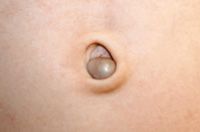Navel battles!
The mother of a 7-month old boy was worried about a nontender, firm, irreducible lump that appeared on his navel 2 months ago.

Key Points
DERMATOLOGY: WHAT'S YOUR DX?
The Case

Spindled and dendritic cells were negative for CD34 and S100 protein; positive testing would have indicated possible malignancy, specifically malignant melanoma. These findings are typical of benign fibrous umbilical polyps.
CLINICAL FINDINGS AND HISTOPATHOLOGY
Umbilical nodules can be found in children and adults. In adults, metastases from intra-abdominal tumors need to be excluded.1,2 Irreducible nodules in children may occur in association with a number of benign umbilical malformations and inflammatory lesions.3
Of 342 lesions evaluated in an 8-year data review of pediatric patients (under age 19 years) at Children's Hospital in Boston, 14 lesions were characterized as well-circumscribed polypoid lesions with moderately cellular fibrotic tissue proliferation within the dermis.4 These lesions were notably lacking thick hyaline collagen bundles, which would have indicated keloids or hypertrophic scars. Thirteen (93%) of the 14 patients were boys, ranging in age from 3 to 18 months.
Previously reported in the literature were 2 cases of "umbilical keloids" in a 14-month-old and a 2-year-old boy,5.6 but these lesions may have been misdiagnosed fibrous umbilical polyps.4
Including our case and the potentially misdiagnosed cases of umbilical keloids, fibrous umbilical polyps have a clear predilection for young boys, suggesting that these lesions define a distinct clinical and pathological entity different from keloids or hypertrophic scars.










Recognize & Refer: Hemangiomas in pediatrics
July 17th 2019Contemporary Pediatrics sits down exclusively with Sheila Fallon Friedlander, MD, a professor dermatology and pediatrics, to discuss the one key condition for which she believes community pediatricians should be especially aware-hemangiomas.
Recognize & Refer: Hemangiomas in pediatrics
July 17th 2019Contemporary Pediatrics sits down exclusively with Sheila Fallon Friedlander, MD, a professor dermatology and pediatrics, to discuss the one key condition for which she believes community pediatricians should be especially aware-hemangiomas.
2 Commerce Drive
Cranbury, NJ 08512
All rights reserved.










